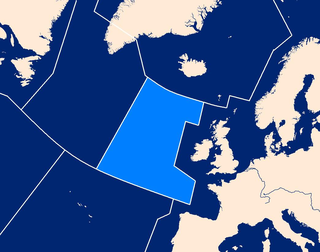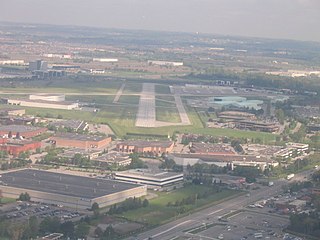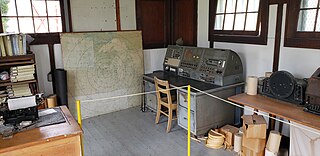Related Research Articles

Air traffic control (ATC) is a service provided by ground-based air traffic controllers who direct aircraft on the ground and through a given section of controlled airspace, and can provide advisory services to aircraft in non-controlled airspace. The primary purpose of ATC worldwide is to prevent collisions, organize and expedite the flow of air traffic, and provide information and other support for pilots.

The London International Airport is an international airport located in London, Ontario, Canada. It is located 5 nautical miles northeast of the city of London, Ontario and is classified as an airport of entry by Nav Canada. In 2011, the airport was listed as the 20th busiest airport in Canada in terms of aircraft movements with 94,747 travels. The airport posted a record 683,000 travelers in 2019 and 340,000 passengers in 2023. It provides services for cargo airlines and year-round flights with Air Canada Express and WestJet.

Shanwick is the air traffic control (ATC) name given to the area of international airspace which lies above the northeast part of the Atlantic Ocean.

Buttonville Municipal Airport or Toronto/Buttonville Municipal Airport was a medium-sized airport in the neighbourhood of Buttonville in Markham, Ontario, Canada, 29 km (18 mi) north of Downtown Toronto, which closed in November 2023. It was operated by Torontair. Due to its location within Toronto's suburbs, there were several strict noise-reduction procedures for aircraft using the airport, which was open and staffed 24 hours a day, 365 days a year. In 2014, Buttonville was Canada's 20th busiest airport by aircraft movements. There was also a weather station located at the airport, which was still operational on the site but closed along with the airport.

Nav Canada is a privately run, non-profit corporation that owns and operates Canada's civil air navigation system (ANS). It was established by statute in accordance with the Civil Air Navigation Services Commercialization Act.

North Bay Airport or North Bay/Jack Garland Airport in North Bay, Ontario, Canada is located at Hornell Heights, 4 nautical miles north-northeast of the city. It is located adjacent to Canadian Forces Base North Bay, operational since 1951, the operational control centre for Canadian operations of the North American Aerospace Defense Command.

Oshawa Executive Airport is a municipal airport adjacent to the north end of the city of Oshawa, Ontario, Canada. It is the busiest general aviation airport without scheduled airline service in the Greater Toronto Area by aircraft movements and one of the busiest general aviation only airports in Canada. It includes two paved runways and instrument approaches.

A flight service station (FSS) is an air traffic facility that provides information and services to aircraft pilots before, during, and after flights, but unlike air traffic control (ATC), is not responsible for giving instructions or clearances or providing separation. They do, however, relay clearances from ATC for departure or approaches. The people who communicate with pilots from an FSS are referred to as flight service specialists.

Windsor International Airport is located in the southeast portion of the city of Windsor, Ontario, Canada. The airport serves a mixture of scheduled airline flights and general aviation, and is a popular point of entry into Canada for private and business aircraft. The airspace above the airport is exceptionally busy because of the proximity to Detroit Metropolitan Airport, and Instrument Flight Rules (IFR) arrivals and departures are handled by Detroit approach control.

Iqaluit Airport serves Iqaluit, Nunavut, Canada and is located adjacent to the city. It hosts scheduled passenger service from Ottawa, Montreal, Rankin Inlet, and Kuujjuaq on carriers such as Canadian North, and from smaller communities throughout eastern Nunavut. It is also used as a forward operating base by the Royal Canadian Air Force (RCAF). In 2011, the terminal handled more than 120,000 passengers.

Penticton Regional Airport, also known as Penticton Airport, is a regional airport located 1.8 nautical miles southwest of Penticton, British Columbia, a city in the Okanagan region of Canada. It is owned and operated by Transport Canada, serving the South Okanagan, Similkameen and West Kootenay areas. Initial examination for the airport's construction began in 1937. The proposed locations were owned by the Penticton Indian Band at that time, but expropriated in 1939.

The Canada Flight Supplement (CFS) is a joint civil/military publication and is a supplement of the Aeronautical Information Publication. It is the nation's official airport directory. It contains information on all registered Canadian and certain Atlantic aerodromes and certified airports.

Naval Air Station Meridian or NAS Meridian is a military airport located 11 miles northeast of Meridian, Mississippi in Lauderdale County and Kemper County, and is one of the Navy's two jet strike pilot training facilities.
A UNICOM station is an air-ground communication facility operated by a non-air traffic control private agency to provide advisory service at uncontrolled aerodromes and airports and to provide various non-flight services, such as requesting a taxi, even at towered airports. It is also known as an aeronautical advisory station, with these terms being used mostly in the Americas. The equivalent European/ICAO service is known as (aerodrome) flight information service, abbreviated as AFIS or FIS. From an ICAO perspective, UNICOM, historically most commonly provided by flight service stations, is an implementation of FIS.

In air traffic control, an area control center (ACC), also known as a center or en-route center, is a facility responsible for controlling aircraft flying in the airspace of a given flight information region (FIR) at high altitudes between airport approaches and departures. In the US, such a center is referred to as an air route traffic control center (ARTCC).
Peace River Airport is a municipally owned airport located 5 nautical miles west of the Town of Peace River, Alberta, Canada. The airport has one runway, which is 5,000 ft × 150 ft, and a terminal building, which is 21,000 sq ft (2,000 m2).
Remote communications outlets (RCO) are remote aviation band radio transceivers, established to extend the communication capabilities of Flight Information Centres (FIC) and flight service stations (FSS).
Ground communications outlets (GCO) have been installed at some U.S. airports to provide a means for pilots on the ground to communicate with flight service stations and air traffic control (ATC) facilities for the purpose of filing, opening and closing VFR or IFR flight plans; obtaining weather briefings and clearances; and similar communications. Larger facilities instead have a remote communications outlet (RCO) installed, which allows pilots to communicate directly over a remote radio transmitter/receiver with the facility. A GCO instead connects with the aircraft/pilot via a radio transmitter/receiver, but with the ground facility via a telephone connection.

Automatic Dependent Surveillance–Broadcast (ADS-B) is an aviation surveillance technology and form of Electronic Conspicuity in which an aircraft determines its position via satellite navigation or other sensors and periodically broadcasts its position and other related data, enabling it to be tracked. The information can be received by air traffic control ground-based or satellite-based receivers as a replacement for secondary surveillance radar (SSR). Unlike SSR, ADS-B does not require an interrogation signal from the ground or from other aircraft to activate its transmissions. ADS-B can also receive point-to-point by other nearby equipped "ADS-B In" equipped aircraft to provide traffic situational awareness and support self-separation. ADS-B is "automatic" in that it requires no pilot or external input to trigger its transmissions. It is "dependent" in that it depends on data from the aircraft's navigation system to provide the transmitted data.

Kingston Norman Rogers Airport or YGK Airport, also known as Kingston Airport, is the main airport serving Kingston, Ontario and its metropolitan area. The airport is named after former MP Norman McLeod Rogers, Minister of Labour and then National Defence in Prime Minister William Lyon Mackenzie King's cabinet. Located 4.3 nautical miles west of downtown Kingston, Ontario, in the west end of the city, it is the largest airport in the region, in 2019 it was reported that 70,000 people travel through the airport each year.
References
- ↑ Transport Canada AIM, RAC 1.1.3 Archived 2010-07-09 at the Wayback Machine